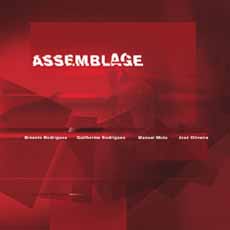
assemblage
Ernesto Rodrigues | Guilherme Rodrigues | Manuel Mota| José Oliveira | cs007
“Language is an obscure thing because it says too much, opaque because it says nothing: ambiguity is everywhere”, Maurice Blanchot once wrote. Quoting it was José Oliveira’s answer to my question “why Assemblage?”. No much more was left to be said: Concepts behind the making of this CD (Ernesto Rodrigues, together with Guilherme Rodrigues and Oliveira - the usual nucleus of his feature works -, always have a conceptual understanding of the practice of improvisation, now extended to guitarist Manuel Mota) surely had a lot more to do with the will to explore ambiguity inherent to the use of a language - musical in this case - than with an affiliation to the spirit of Dada, inventor of those sculptural compositions to which the word “assemblage” was applied to, like, for instance, a card box full of objects placed by some small tree branches, peaces of fabric, paper rolls and a frieze of small oils on canvas.
References are to be found in arts (Fluxus, New Realism and Arte Povera also did use poor raw materials, rubbish and junk) but what really seems to make this quartet move are linguistic matters inherent to an understanding of music which refuses the possibility of narrative and even the linearity of human language itself, former basis of all musical procedures throughout history. But it is also a fact that there’s no music without some form of sequentiality, which means that the type of ambiguity to which «Assemblage» aspires to has as foreground the dematerialization of the musical “object” by means of a fragmented, even splintered, speech (somehow a non-speech) and the use of static structures (non-structures, at least in the traditional music sense, given the absolute inexistence of any thematic developments). If you think of Xenakis’ idea that music is Architecture in motion it is at least a curious fact to realize that Mota is an architect, which turns his contributions to these improvisations into an evidence.
And
this is how the idea of “assemblage” assumes a double character. On one
hand visual analogies from parasite manipulations of the instruments,
always seeking the “dirty zones” of sound (the “forsaken region
of music”, as José Oliveira calls it, he himself also a visual
artist), what you could call the “poor” sounds, its outgrouths, and also
the remaining sound during the absence of sound, what you’d call subliminal
sound; on the other hand the coupling of very diverse sound materials,
even opposed and incongruent - as far as one may say so - which just doesn’t
get things into textural overload because the only pre-established rule
is to play the minimum possible.
As a matter of fact, never before these musicians - as a group or by themselves
- had achieved such a degree of depuration. A quality which you seldom
associate to strategies of expressive intensity but is to be found here,
assembled, ambiguous, Marcel Duchamp mixed with Julia Kristeva.
Rui Eduardo Paes - (journalist and music writer)